EDLA264: Early Literacy Teaching and Learning Activities Design
VerifiedAdded on 2022/09/08
|12
|3223
|26
Homework Assignment
AI Summary
This assignment solution focuses on designing early literacy teaching and learning activities for K-2 students, based on the book "We're Going on a Bear Hunt." It addresses the Australian curriculum, emphasizing creative thinking, literacy, and language development. The solution includes detailed learning plans, incorporating comprehension, vocabulary, visual literacy, spelling, phonics, and phonological awareness activities. It discusses the importance of reading to children, the use of technology, and the integration of various learning intentions and success criteria. The assignment also covers the rationale behind activity choices, drawing on language and literacy theory to support the proposed teaching methods and assessment strategies. It also presents the use of video and digital devices in teaching.
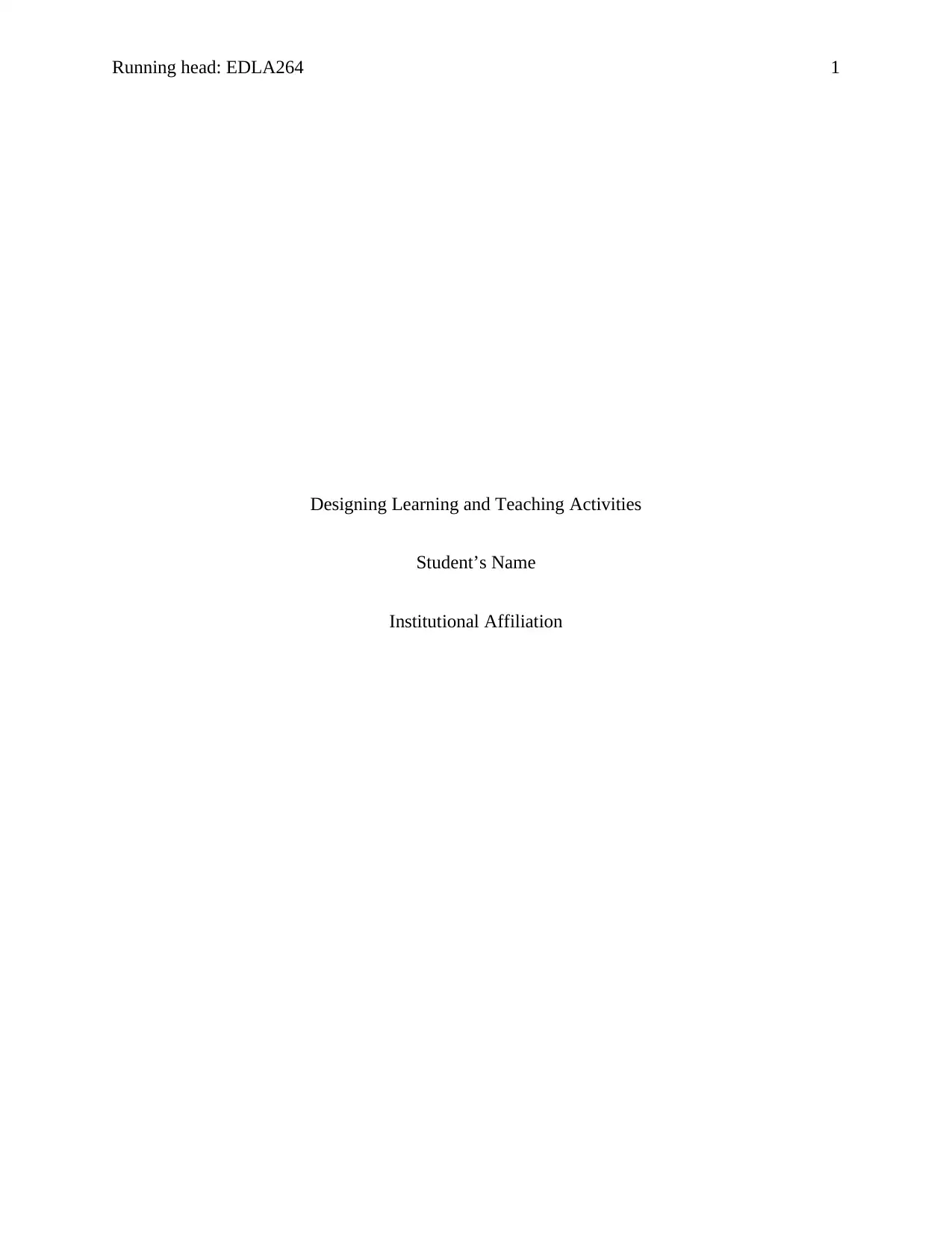
Running head: EDLA264 1
Designing Learning and Teaching Activities
Student’s Name
Institutional Affiliation
Designing Learning and Teaching Activities
Student’s Name
Institutional Affiliation
Paraphrase This Document
Need a fresh take? Get an instant paraphrase of this document with our AI Paraphraser
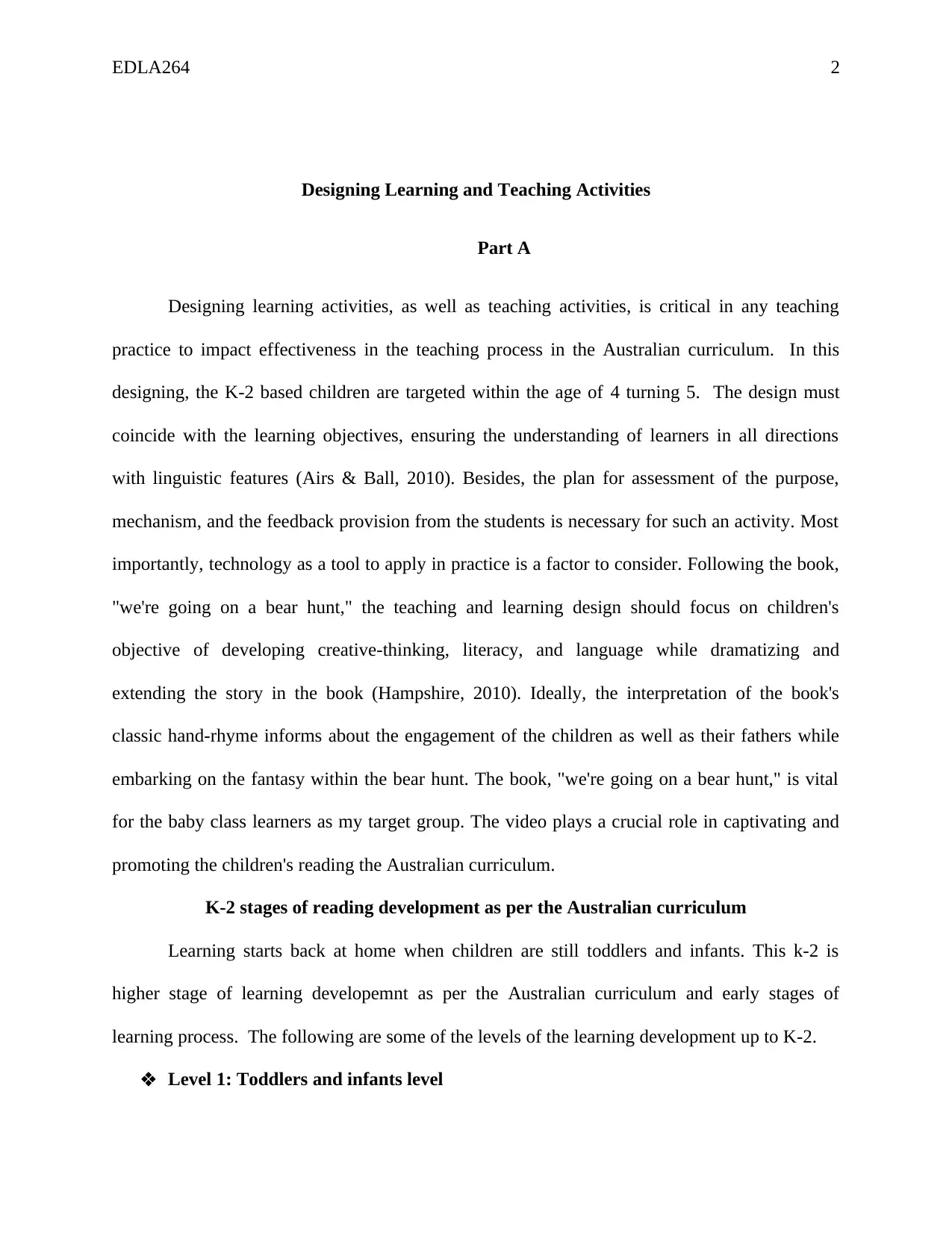
EDLA264 2
Designing Learning and Teaching Activities
Part A
Designing learning activities, as well as teaching activities, is critical in any teaching
practice to impact effectiveness in the teaching process in the Australian curriculum. In this
designing, the K-2 based children are targeted within the age of 4 turning 5. The design must
coincide with the learning objectives, ensuring the understanding of learners in all directions
with linguistic features (Airs & Ball, 2010). Besides, the plan for assessment of the purpose,
mechanism, and the feedback provision from the students is necessary for such an activity. Most
importantly, technology as a tool to apply in practice is a factor to consider. Following the book,
"we're going on a bear hunt," the teaching and learning design should focus on children's
objective of developing creative-thinking, literacy, and language while dramatizing and
extending the story in the book (Hampshire, 2010). Ideally, the interpretation of the book's
classic hand-rhyme informs about the engagement of the children as well as their fathers while
embarking on the fantasy within the bear hunt. The book, "we're going on a bear hunt," is vital
for the baby class learners as my target group. The video plays a crucial role in captivating and
promoting the children's reading the Australian curriculum.
K-2 stages of reading development as per the Australian curriculum
Learning starts back at home when children are still toddlers and infants. This k-2 is
higher stage of learning developemnt as per the Australian curriculum and early stages of
learning process. The following are some of the levels of the learning development up to K-2.
Level 1: Toddlers and infants level
Designing Learning and Teaching Activities
Part A
Designing learning activities, as well as teaching activities, is critical in any teaching
practice to impact effectiveness in the teaching process in the Australian curriculum. In this
designing, the K-2 based children are targeted within the age of 4 turning 5. The design must
coincide with the learning objectives, ensuring the understanding of learners in all directions
with linguistic features (Airs & Ball, 2010). Besides, the plan for assessment of the purpose,
mechanism, and the feedback provision from the students is necessary for such an activity. Most
importantly, technology as a tool to apply in practice is a factor to consider. Following the book,
"we're going on a bear hunt," the teaching and learning design should focus on children's
objective of developing creative-thinking, literacy, and language while dramatizing and
extending the story in the book (Hampshire, 2010). Ideally, the interpretation of the book's
classic hand-rhyme informs about the engagement of the children as well as their fathers while
embarking on the fantasy within the bear hunt. The book, "we're going on a bear hunt," is vital
for the baby class learners as my target group. The video plays a crucial role in captivating and
promoting the children's reading the Australian curriculum.
K-2 stages of reading development as per the Australian curriculum
Learning starts back at home when children are still toddlers and infants. This k-2 is
higher stage of learning developemnt as per the Australian curriculum and early stages of
learning process. The following are some of the levels of the learning development up to K-2.
Level 1: Toddlers and infants level
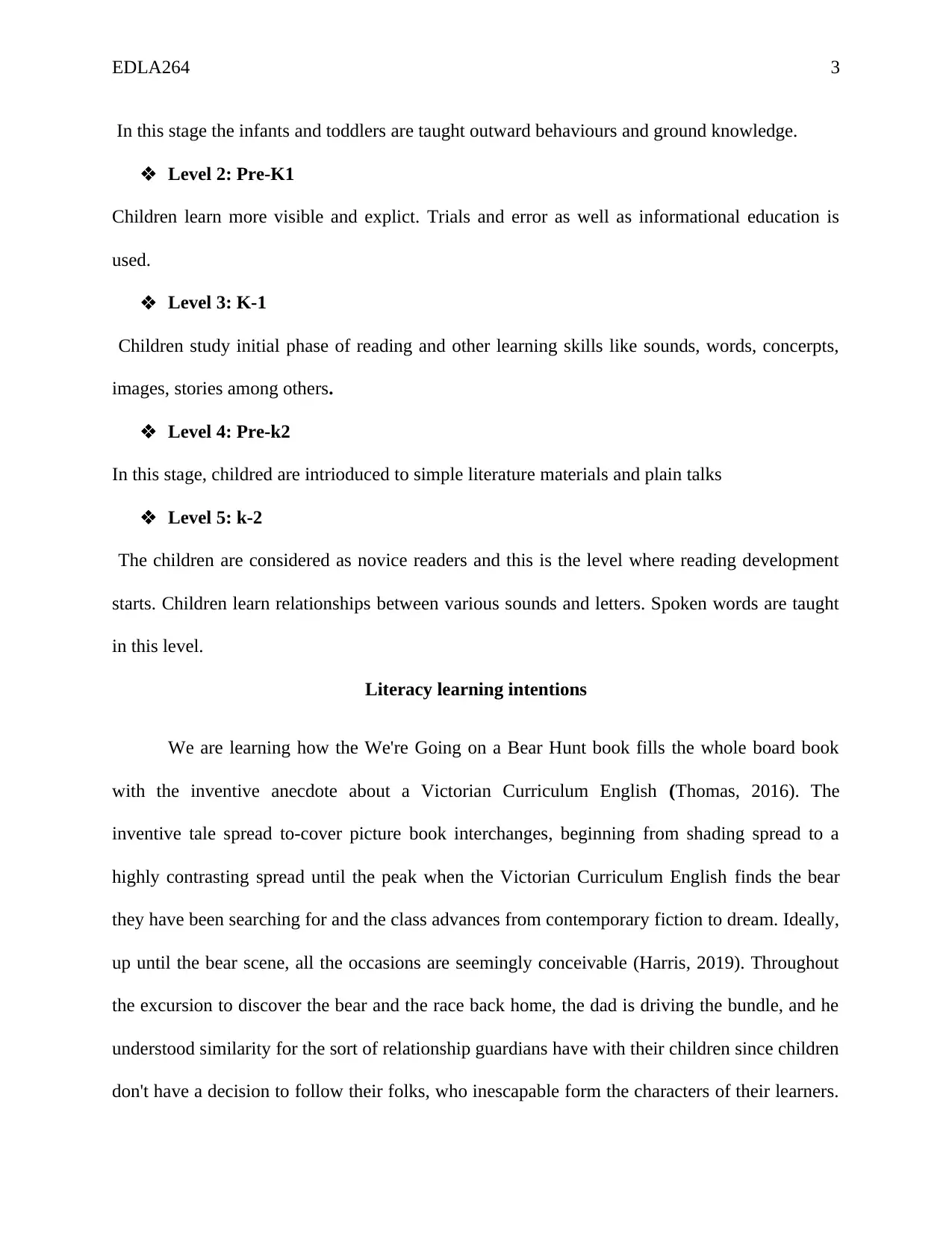
EDLA264 3
In this stage the infants and toddlers are taught outward behaviours and ground knowledge.
Level 2: Pre-K1
Children learn more visible and explict. Trials and error as well as informational education is
used.
Level 3: K-1
Children study initial phase of reading and other learning skills like sounds, words, concerpts,
images, stories among others.
Level 4: Pre-k2
In this stage, childred are intrioduced to simple literature materials and plain talks
Level 5: k-2
The children are considered as novice readers and this is the level where reading development
starts. Children learn relationships between various sounds and letters. Spoken words are taught
in this level.
Literacy learning intentions
We are learning how the We're Going on a Bear Hunt book fills the whole board book
with the inventive anecdote about a Victorian Curriculum English (Thomas, 2016). The
inventive tale spread to-cover picture book interchanges, beginning from shading spread to a
highly contrasting spread until the peak when the Victorian Curriculum English finds the bear
they have been searching for and the class advances from contemporary fiction to dream. Ideally,
up until the bear scene, all the occasions are seemingly conceivable (Harris, 2019). Throughout
the excursion to discover the bear and the race back home, the dad is driving the bundle, and he
understood similarity for the sort of relationship guardians have with their children since children
don't have a decision to follow their folks, who inescapable form the characters of their learners.
In this stage the infants and toddlers are taught outward behaviours and ground knowledge.
Level 2: Pre-K1
Children learn more visible and explict. Trials and error as well as informational education is
used.
Level 3: K-1
Children study initial phase of reading and other learning skills like sounds, words, concerpts,
images, stories among others.
Level 4: Pre-k2
In this stage, childred are intrioduced to simple literature materials and plain talks
Level 5: k-2
The children are considered as novice readers and this is the level where reading development
starts. Children learn relationships between various sounds and letters. Spoken words are taught
in this level.
Literacy learning intentions
We are learning how the We're Going on a Bear Hunt book fills the whole board book
with the inventive anecdote about a Victorian Curriculum English (Thomas, 2016). The
inventive tale spread to-cover picture book interchanges, beginning from shading spread to a
highly contrasting spread until the peak when the Victorian Curriculum English finds the bear
they have been searching for and the class advances from contemporary fiction to dream. Ideally,
up until the bear scene, all the occasions are seemingly conceivable (Harris, 2019). Throughout
the excursion to discover the bear and the race back home, the dad is driving the bundle, and he
understood similarity for the sort of relationship guardians have with their children since children
don't have a decision to follow their folks, who inescapable form the characters of their learners.
⊘ This is a preview!⊘
Do you want full access?
Subscribe today to unlock all pages.

Trusted by 1+ million students worldwide
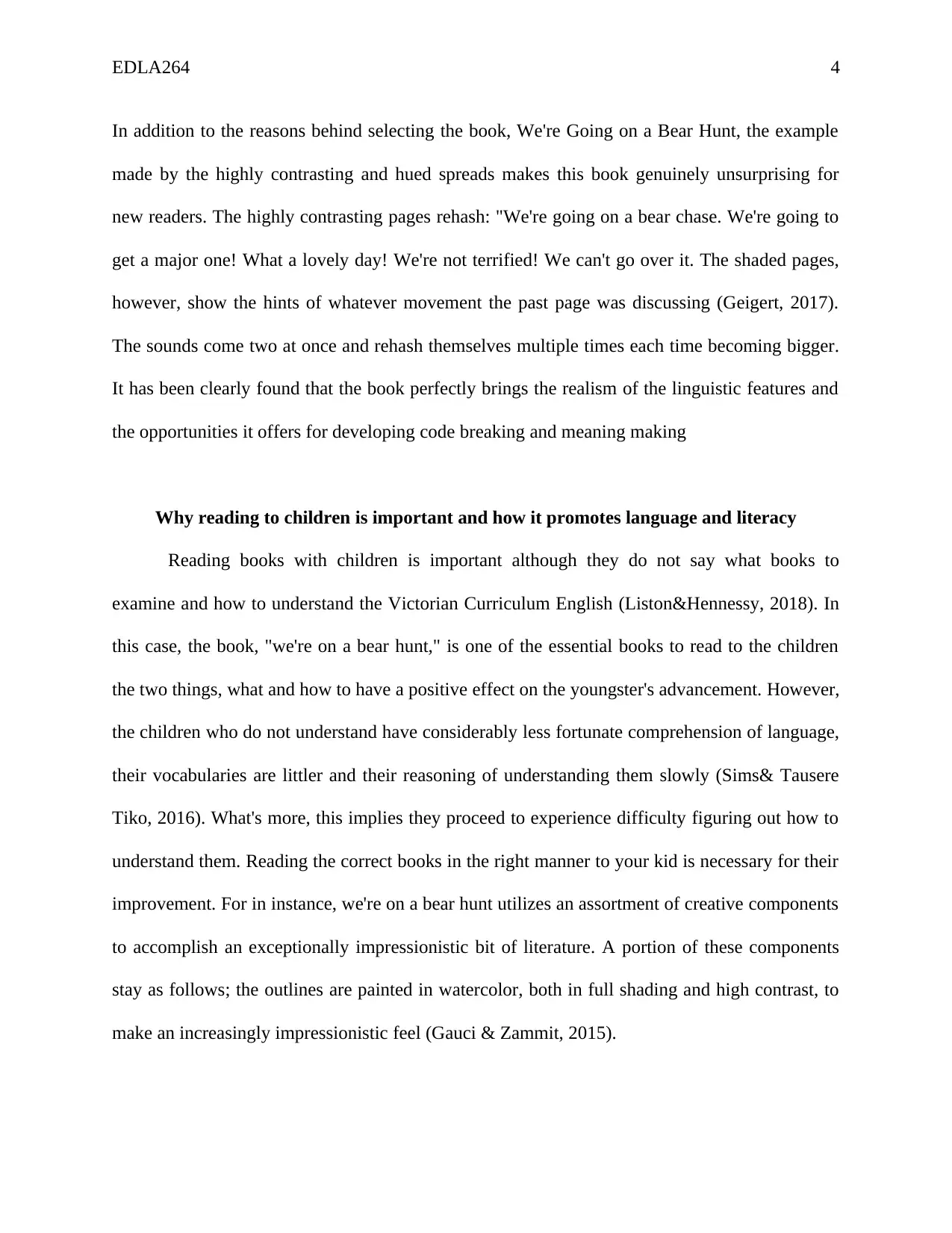
EDLA264 4
In addition to the reasons behind selecting the book, We're Going on a Bear Hunt, the example
made by the highly contrasting and hued spreads makes this book genuinely unsurprising for
new readers. The highly contrasting pages rehash: "We're going on a bear chase. We're going to
get a major one! What a lovely day! We're not terrified! We can't go over it. The shaded pages,
however, show the hints of whatever movement the past page was discussing (Geigert, 2017).
The sounds come two at once and rehash themselves multiple times each time becoming bigger.
It has been clearly found that the book perfectly brings the realism of the linguistic features and
the opportunities it offers for developing code breaking and meaning making
Why reading to children is important and how it promotes language and literacy
Reading books with children is important although they do not say what books to
examine and how to understand the Victorian Curriculum English (Liston&Hennessy, 2018). In
this case, the book, "we're on a bear hunt," is one of the essential books to read to the children
the two things, what and how to have a positive effect on the youngster's advancement. However,
the children who do not understand have considerably less fortunate comprehension of language,
their vocabularies are littler and their reasoning of understanding them slowly (Sims& Tausere
Tiko, 2016). What's more, this implies they proceed to experience difficulty figuring out how to
understand them. Reading the correct books in the right manner to your kid is necessary for their
improvement. For in instance, we're on a bear hunt utilizes an assortment of creative components
to accomplish an exceptionally impressionistic bit of literature. A portion of these components
stay as follows; the outlines are painted in watercolor, both in full shading and high contrast, to
make an increasingly impressionistic feel (Gauci & Zammit, 2015).
In addition to the reasons behind selecting the book, We're Going on a Bear Hunt, the example
made by the highly contrasting and hued spreads makes this book genuinely unsurprising for
new readers. The highly contrasting pages rehash: "We're going on a bear chase. We're going to
get a major one! What a lovely day! We're not terrified! We can't go over it. The shaded pages,
however, show the hints of whatever movement the past page was discussing (Geigert, 2017).
The sounds come two at once and rehash themselves multiple times each time becoming bigger.
It has been clearly found that the book perfectly brings the realism of the linguistic features and
the opportunities it offers for developing code breaking and meaning making
Why reading to children is important and how it promotes language and literacy
Reading books with children is important although they do not say what books to
examine and how to understand the Victorian Curriculum English (Liston&Hennessy, 2018). In
this case, the book, "we're on a bear hunt," is one of the essential books to read to the children
the two things, what and how to have a positive effect on the youngster's advancement. However,
the children who do not understand have considerably less fortunate comprehension of language,
their vocabularies are littler and their reasoning of understanding them slowly (Sims& Tausere
Tiko, 2016). What's more, this implies they proceed to experience difficulty figuring out how to
understand them. Reading the correct books in the right manner to your kid is necessary for their
improvement. For in instance, we're on a bear hunt utilizes an assortment of creative components
to accomplish an exceptionally impressionistic bit of literature. A portion of these components
stay as follows; the outlines are painted in watercolor, both in full shading and high contrast, to
make an increasingly impressionistic feel (Gauci & Zammit, 2015).
Paraphrase This Document
Need a fresh take? Get an instant paraphrase of this document with our AI Paraphraser
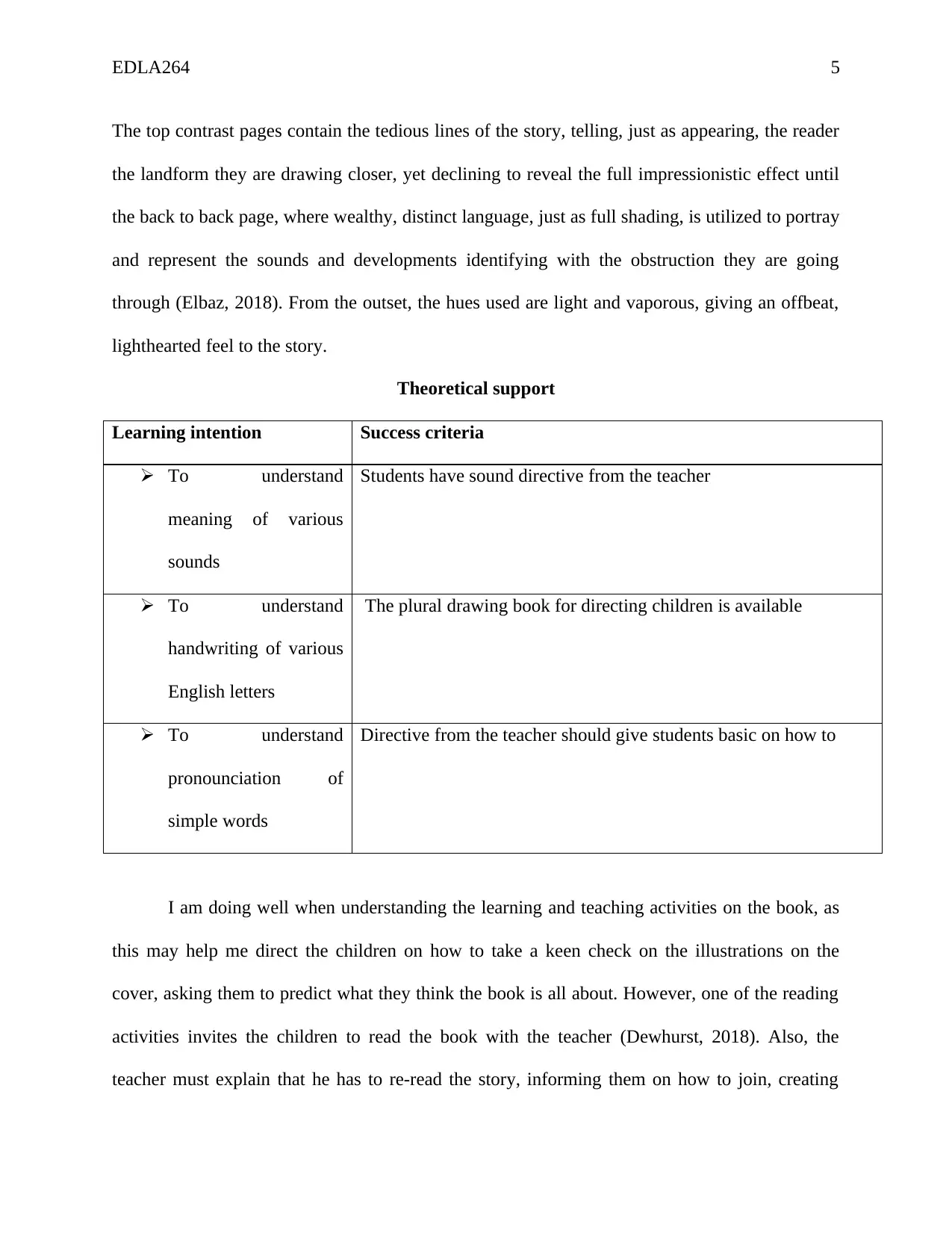
EDLA264 5
The top contrast pages contain the tedious lines of the story, telling, just as appearing, the reader
the landform they are drawing closer, yet declining to reveal the full impressionistic effect until
the back to back page, where wealthy, distinct language, just as full shading, is utilized to portray
and represent the sounds and developments identifying with the obstruction they are going
through (Elbaz, 2018). From the outset, the hues used are light and vaporous, giving an offbeat,
lighthearted feel to the story.
Theoretical support
Learning intention Success criteria
To understand
meaning of various
sounds
Students have sound directive from the teacher
To understand
handwriting of various
English letters
The plural drawing book for directing children is available
To understand
pronounciation of
simple words
Directive from the teacher should give students basic on how to
I am doing well when understanding the learning and teaching activities on the book, as
this may help me direct the children on how to take a keen check on the illustrations on the
cover, asking them to predict what they think the book is all about. However, one of the reading
activities invites the children to read the book with the teacher (Dewhurst, 2018). Also, the
teacher must explain that he has to re-read the story, informing them on how to join, creating
The top contrast pages contain the tedious lines of the story, telling, just as appearing, the reader
the landform they are drawing closer, yet declining to reveal the full impressionistic effect until
the back to back page, where wealthy, distinct language, just as full shading, is utilized to portray
and represent the sounds and developments identifying with the obstruction they are going
through (Elbaz, 2018). From the outset, the hues used are light and vaporous, giving an offbeat,
lighthearted feel to the story.
Theoretical support
Learning intention Success criteria
To understand
meaning of various
sounds
Students have sound directive from the teacher
To understand
handwriting of various
English letters
The plural drawing book for directing children is available
To understand
pronounciation of
simple words
Directive from the teacher should give students basic on how to
I am doing well when understanding the learning and teaching activities on the book, as
this may help me direct the children on how to take a keen check on the illustrations on the
cover, asking them to predict what they think the book is all about. However, one of the reading
activities invites the children to read the book with the teacher (Dewhurst, 2018). Also, the
teacher must explain that he has to re-read the story, informing them on how to join, creating
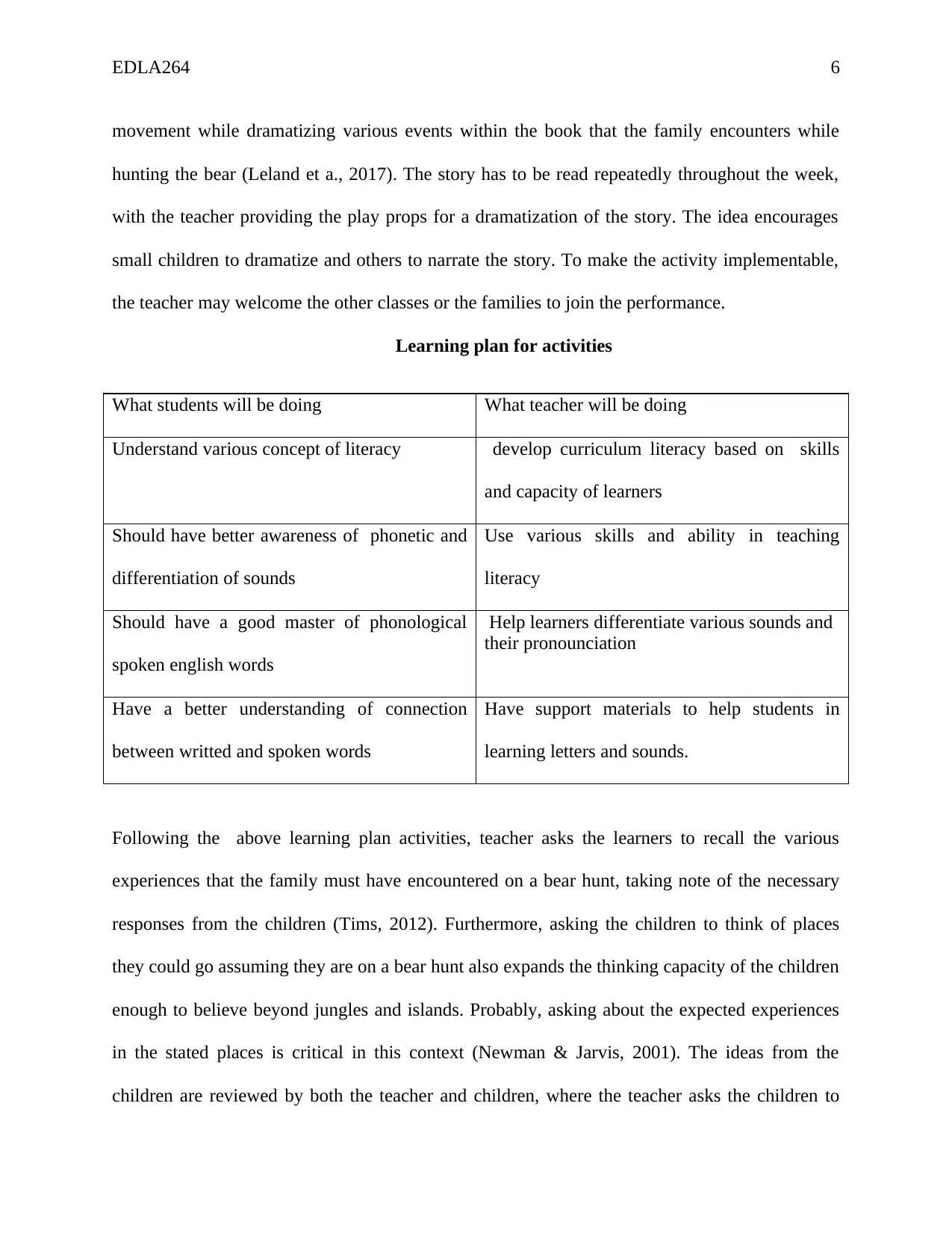
EDLA264 6
movement while dramatizing various events within the book that the family encounters while
hunting the bear (Leland et a., 2017). The story has to be read repeatedly throughout the week,
with the teacher providing the play props for a dramatization of the story. The idea encourages
small children to dramatize and others to narrate the story. To make the activity implementable,
the teacher may welcome the other classes or the families to join the performance.
Learning plan for activities
What students will be doing What teacher will be doing
Understand various concept of literacy develop curriculum literacy based on skills
and capacity of learners
Should have better awareness of phonetic and
differentiation of sounds
Use various skills and ability in teaching
literacy
Should have a good master of phonological
spoken english words
Help learners differentiate various sounds and
their pronounciation
Have a better understanding of connection
between writted and spoken words
Have support materials to help students in
learning letters and sounds.
Following the above learning plan activities, teacher asks the learners to recall the various
experiences that the family must have encountered on a bear hunt, taking note of the necessary
responses from the children (Tims, 2012). Furthermore, asking the children to think of places
they could go assuming they are on a bear hunt also expands the thinking capacity of the children
enough to believe beyond jungles and islands. Probably, asking about the expected experiences
in the stated places is critical in this context (Newman & Jarvis, 2001). The ideas from the
children are reviewed by both the teacher and children, where the teacher asks the children to
movement while dramatizing various events within the book that the family encounters while
hunting the bear (Leland et a., 2017). The story has to be read repeatedly throughout the week,
with the teacher providing the play props for a dramatization of the story. The idea encourages
small children to dramatize and others to narrate the story. To make the activity implementable,
the teacher may welcome the other classes or the families to join the performance.
Learning plan for activities
What students will be doing What teacher will be doing
Understand various concept of literacy develop curriculum literacy based on skills
and capacity of learners
Should have better awareness of phonetic and
differentiation of sounds
Use various skills and ability in teaching
literacy
Should have a good master of phonological
spoken english words
Help learners differentiate various sounds and
their pronounciation
Have a better understanding of connection
between writted and spoken words
Have support materials to help students in
learning letters and sounds.
Following the above learning plan activities, teacher asks the learners to recall the various
experiences that the family must have encountered on a bear hunt, taking note of the necessary
responses from the children (Tims, 2012). Furthermore, asking the children to think of places
they could go assuming they are on a bear hunt also expands the thinking capacity of the children
enough to believe beyond jungles and islands. Probably, asking about the expected experiences
in the stated places is critical in this context (Newman & Jarvis, 2001). The ideas from the
children are reviewed by both the teacher and children, where the teacher asks the children to
⊘ This is a preview!⊘
Do you want full access?
Subscribe today to unlock all pages.

Trusted by 1+ million students worldwide
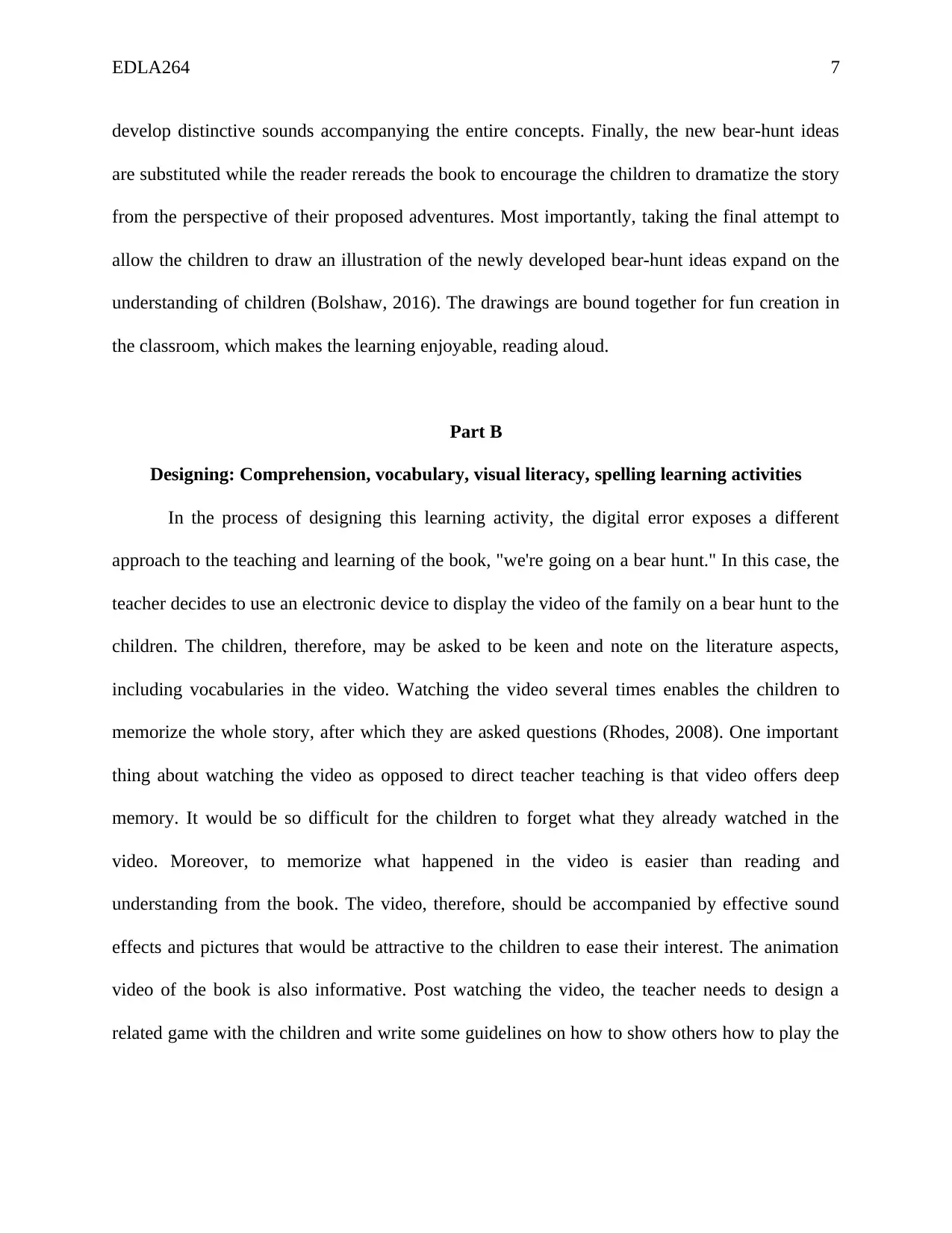
EDLA264 7
develop distinctive sounds accompanying the entire concepts. Finally, the new bear-hunt ideas
are substituted while the reader rereads the book to encourage the children to dramatize the story
from the perspective of their proposed adventures. Most importantly, taking the final attempt to
allow the children to draw an illustration of the newly developed bear-hunt ideas expand on the
understanding of children (Bolshaw, 2016). The drawings are bound together for fun creation in
the classroom, which makes the learning enjoyable, reading aloud.
Part B
Designing: Comprehension, vocabulary, visual literacy, spelling learning activities
In the process of designing this learning activity, the digital error exposes a different
approach to the teaching and learning of the book, "we're going on a bear hunt." In this case, the
teacher decides to use an electronic device to display the video of the family on a bear hunt to the
children. The children, therefore, may be asked to be keen and note on the literature aspects,
including vocabularies in the video. Watching the video several times enables the children to
memorize the whole story, after which they are asked questions (Rhodes, 2008). One important
thing about watching the video as opposed to direct teacher teaching is that video offers deep
memory. It would be so difficult for the children to forget what they already watched in the
video. Moreover, to memorize what happened in the video is easier than reading and
understanding from the book. The video, therefore, should be accompanied by effective sound
effects and pictures that would be attractive to the children to ease their interest. The animation
video of the book is also informative. Post watching the video, the teacher needs to design a
related game with the children and write some guidelines on how to show others how to play the
develop distinctive sounds accompanying the entire concepts. Finally, the new bear-hunt ideas
are substituted while the reader rereads the book to encourage the children to dramatize the story
from the perspective of their proposed adventures. Most importantly, taking the final attempt to
allow the children to draw an illustration of the newly developed bear-hunt ideas expand on the
understanding of children (Bolshaw, 2016). The drawings are bound together for fun creation in
the classroom, which makes the learning enjoyable, reading aloud.
Part B
Designing: Comprehension, vocabulary, visual literacy, spelling learning activities
In the process of designing this learning activity, the digital error exposes a different
approach to the teaching and learning of the book, "we're going on a bear hunt." In this case, the
teacher decides to use an electronic device to display the video of the family on a bear hunt to the
children. The children, therefore, may be asked to be keen and note on the literature aspects,
including vocabularies in the video. Watching the video several times enables the children to
memorize the whole story, after which they are asked questions (Rhodes, 2008). One important
thing about watching the video as opposed to direct teacher teaching is that video offers deep
memory. It would be so difficult for the children to forget what they already watched in the
video. Moreover, to memorize what happened in the video is easier than reading and
understanding from the book. The video, therefore, should be accompanied by effective sound
effects and pictures that would be attractive to the children to ease their interest. The animation
video of the book is also informative. Post watching the video, the teacher needs to design a
related game with the children and write some guidelines on how to show others how to play the
Paraphrase This Document
Need a fresh take? Get an instant paraphrase of this document with our AI Paraphraser
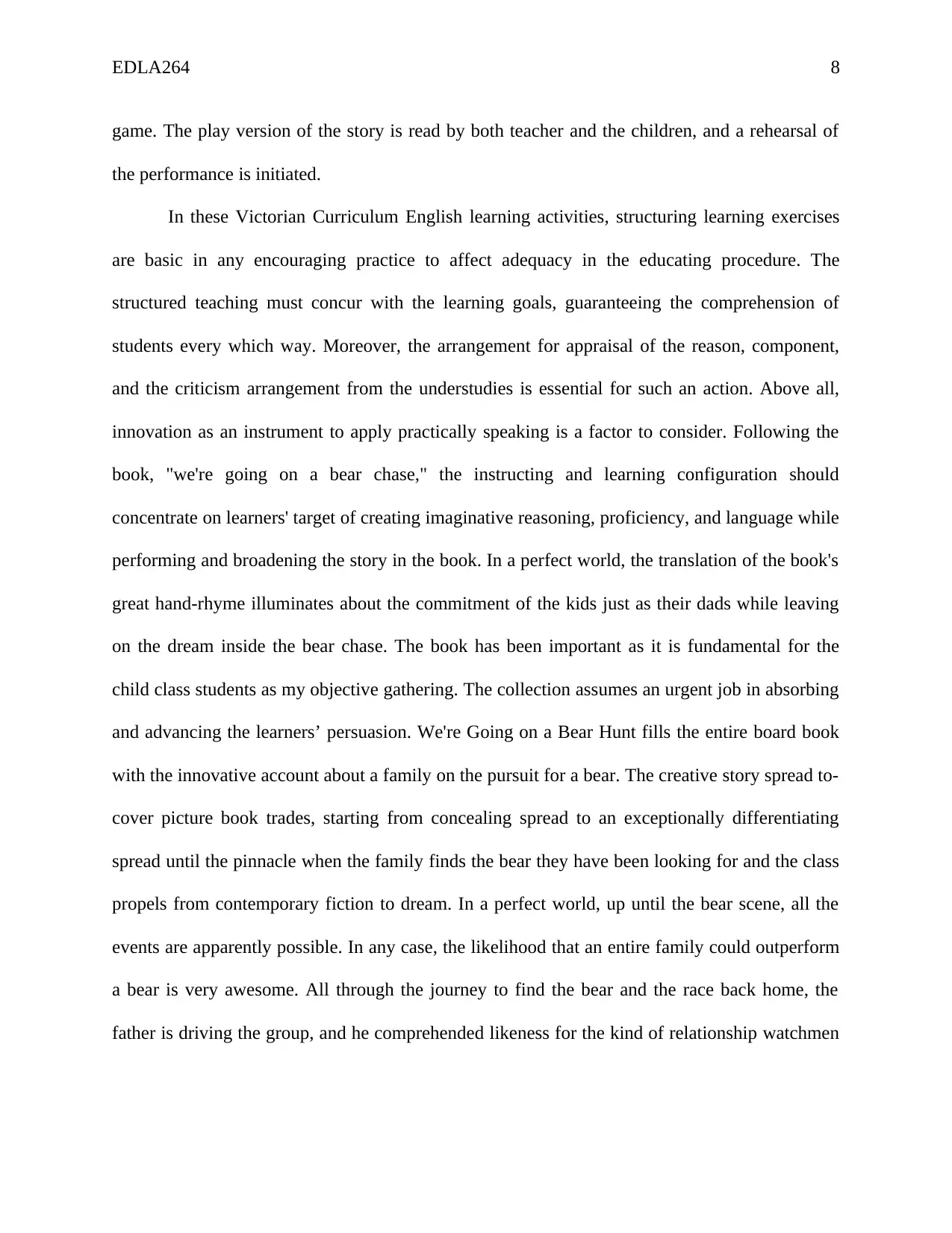
EDLA264 8
game. The play version of the story is read by both teacher and the children, and a rehearsal of
the performance is initiated.
In these Victorian Curriculum English learning activities, structuring learning exercises
are basic in any encouraging practice to affect adequacy in the educating procedure. The
structured teaching must concur with the learning goals, guaranteeing the comprehension of
students every which way. Moreover, the arrangement for appraisal of the reason, component,
and the criticism arrangement from the understudies is essential for such an action. Above all,
innovation as an instrument to apply practically speaking is a factor to consider. Following the
book, "we're going on a bear chase," the instructing and learning configuration should
concentrate on learners' target of creating imaginative reasoning, proficiency, and language while
performing and broadening the story in the book. In a perfect world, the translation of the book's
great hand-rhyme illuminates about the commitment of the kids just as their dads while leaving
on the dream inside the bear chase. The book has been important as it is fundamental for the
child class students as my objective gathering. The collection assumes an urgent job in absorbing
and advancing the learners’ persuasion. We're Going on a Bear Hunt fills the entire board book
with the innovative account about a family on the pursuit for a bear. The creative story spread to-
cover picture book trades, starting from concealing spread to an exceptionally differentiating
spread until the pinnacle when the family finds the bear they have been looking for and the class
propels from contemporary fiction to dream. In a perfect world, up until the bear scene, all the
events are apparently possible. In any case, the likelihood that an entire family could outperform
a bear is very awesome. All through the journey to find the bear and the race back home, the
father is driving the group, and he comprehended likeness for the kind of relationship watchmen
game. The play version of the story is read by both teacher and the children, and a rehearsal of
the performance is initiated.
In these Victorian Curriculum English learning activities, structuring learning exercises
are basic in any encouraging practice to affect adequacy in the educating procedure. The
structured teaching must concur with the learning goals, guaranteeing the comprehension of
students every which way. Moreover, the arrangement for appraisal of the reason, component,
and the criticism arrangement from the understudies is essential for such an action. Above all,
innovation as an instrument to apply practically speaking is a factor to consider. Following the
book, "we're going on a bear chase," the instructing and learning configuration should
concentrate on learners' target of creating imaginative reasoning, proficiency, and language while
performing and broadening the story in the book. In a perfect world, the translation of the book's
great hand-rhyme illuminates about the commitment of the kids just as their dads while leaving
on the dream inside the bear chase. The book has been important as it is fundamental for the
child class students as my objective gathering. The collection assumes an urgent job in absorbing
and advancing the learners’ persuasion. We're Going on a Bear Hunt fills the entire board book
with the innovative account about a family on the pursuit for a bear. The creative story spread to-
cover picture book trades, starting from concealing spread to an exceptionally differentiating
spread until the pinnacle when the family finds the bear they have been looking for and the class
propels from contemporary fiction to dream. In a perfect world, up until the bear scene, all the
events are apparently possible. In any case, the likelihood that an entire family could outperform
a bear is very awesome. All through the journey to find the bear and the race back home, the
father is driving the group, and he comprehended likeness for the kind of relationship watchmen
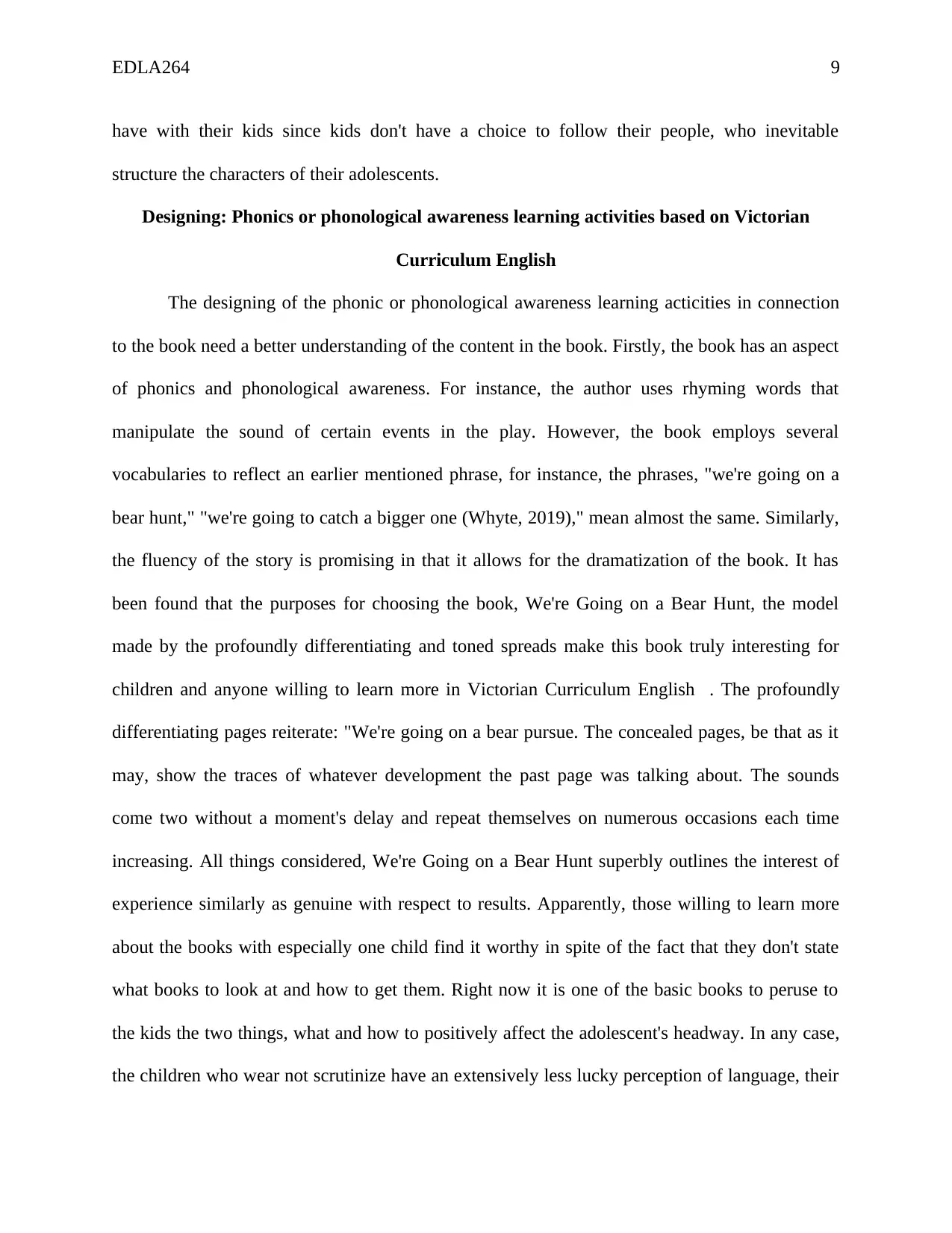
EDLA264 9
have with their kids since kids don't have a choice to follow their people, who inevitable
structure the characters of their adolescents.
Designing: Phonics or phonological awareness learning activities based on Victorian
Curriculum English
The designing of the phonic or phonological awareness learning acticities in connection
to the book need a better understanding of the content in the book. Firstly, the book has an aspect
of phonics and phonological awareness. For instance, the author uses rhyming words that
manipulate the sound of certain events in the play. However, the book employs several
vocabularies to reflect an earlier mentioned phrase, for instance, the phrases, "we're going on a
bear hunt," "we're going to catch a bigger one (Whyte, 2019)," mean almost the same. Similarly,
the fluency of the story is promising in that it allows for the dramatization of the book. It has
been found that the purposes for choosing the book, We're Going on a Bear Hunt, the model
made by the profoundly differentiating and toned spreads make this book truly interesting for
children and anyone willing to learn more in Victorian Curriculum English . The profoundly
differentiating pages reiterate: "We're going on a bear pursue. The concealed pages, be that as it
may, show the traces of whatever development the past page was talking about. The sounds
come two without a moment's delay and repeat themselves on numerous occasions each time
increasing. All things considered, We're Going on a Bear Hunt superbly outlines the interest of
experience similarly as genuine with respect to results. Apparently, those willing to learn more
about the books with especially one child find it worthy in spite of the fact that they don't state
what books to look at and how to get them. Right now it is one of the basic books to peruse to
the kids the two things, what and how to positively affect the adolescent's headway. In any case,
the children who wear not scrutinize have an extensively less lucky perception of language, their
have with their kids since kids don't have a choice to follow their people, who inevitable
structure the characters of their adolescents.
Designing: Phonics or phonological awareness learning activities based on Victorian
Curriculum English
The designing of the phonic or phonological awareness learning acticities in connection
to the book need a better understanding of the content in the book. Firstly, the book has an aspect
of phonics and phonological awareness. For instance, the author uses rhyming words that
manipulate the sound of certain events in the play. However, the book employs several
vocabularies to reflect an earlier mentioned phrase, for instance, the phrases, "we're going on a
bear hunt," "we're going to catch a bigger one (Whyte, 2019)," mean almost the same. Similarly,
the fluency of the story is promising in that it allows for the dramatization of the book. It has
been found that the purposes for choosing the book, We're Going on a Bear Hunt, the model
made by the profoundly differentiating and toned spreads make this book truly interesting for
children and anyone willing to learn more in Victorian Curriculum English . The profoundly
differentiating pages reiterate: "We're going on a bear pursue. The concealed pages, be that as it
may, show the traces of whatever development the past page was talking about. The sounds
come two without a moment's delay and repeat themselves on numerous occasions each time
increasing. All things considered, We're Going on a Bear Hunt superbly outlines the interest of
experience similarly as genuine with respect to results. Apparently, those willing to learn more
about the books with especially one child find it worthy in spite of the fact that they don't state
what books to look at and how to get them. Right now it is one of the basic books to peruse to
the kids the two things, what and how to positively affect the adolescent's headway. In any case,
the children who wear not scrutinize have an extensively less lucky perception of language, their
⊘ This is a preview!⊘
Do you want full access?
Subscribe today to unlock all pages.

Trusted by 1+ million students worldwide
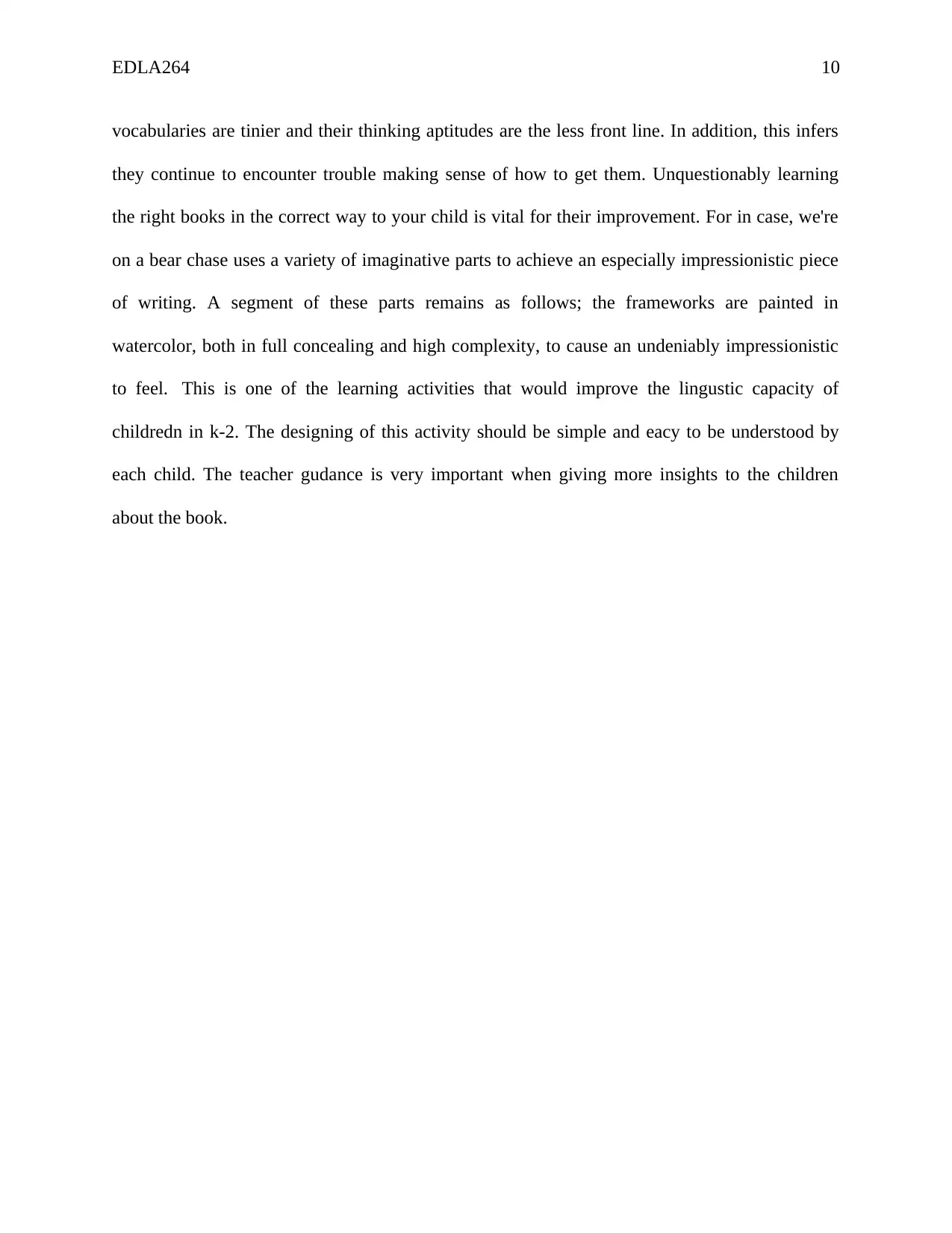
EDLA264 10
vocabularies are tinier and their thinking aptitudes are the less front line. In addition, this infers
they continue to encounter trouble making sense of how to get them. Unquestionably learning
the right books in the correct way to your child is vital for their improvement. For in case, we're
on a bear chase uses a variety of imaginative parts to achieve an especially impressionistic piece
of writing. A segment of these parts remains as follows; the frameworks are painted in
watercolor, both in full concealing and high complexity, to cause an undeniably impressionistic
to feel. This is one of the learning activities that would improve the lingustic capacity of
childredn in k-2. The designing of this activity should be simple and eacy to be understood by
each child. The teacher gudance is very important when giving more insights to the children
about the book.
vocabularies are tinier and their thinking aptitudes are the less front line. In addition, this infers
they continue to encounter trouble making sense of how to get them. Unquestionably learning
the right books in the correct way to your child is vital for their improvement. For in case, we're
on a bear chase uses a variety of imaginative parts to achieve an especially impressionistic piece
of writing. A segment of these parts remains as follows; the frameworks are painted in
watercolor, both in full concealing and high complexity, to cause an undeniably impressionistic
to feel. This is one of the learning activities that would improve the lingustic capacity of
childredn in k-2. The designing of this activity should be simple and eacy to be understood by
each child. The teacher gudance is very important when giving more insights to the children
about the book.
Paraphrase This Document
Need a fresh take? Get an instant paraphrase of this document with our AI Paraphraser
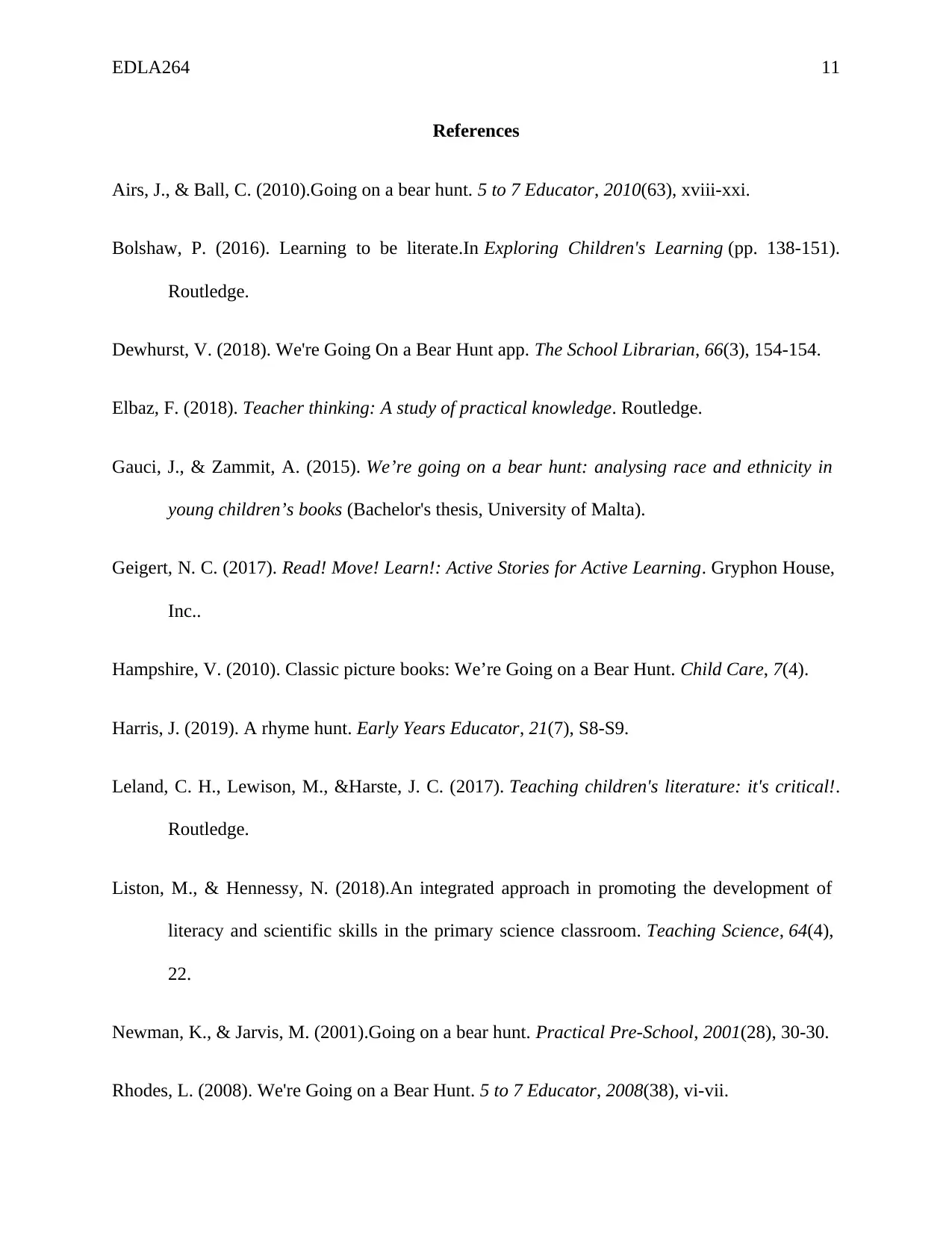
EDLA264 11
References
Airs, J., & Ball, C. (2010).Going on a bear hunt. 5 to 7 Educator, 2010(63), xviii-xxi.
Bolshaw, P. (2016). Learning to be literate.In Exploring Children's Learning (pp. 138-151).
Routledge.
Dewhurst, V. (2018). We're Going On a Bear Hunt app. The School Librarian, 66(3), 154-154.
Elbaz, F. (2018). Teacher thinking: A study of practical knowledge. Routledge.
Gauci, J., & Zammit, A. (2015). We’re going on a bear hunt: analysing race and ethnicity in
young children’s books (Bachelor's thesis, University of Malta).
Geigert, N. C. (2017). Read! Move! Learn!: Active Stories for Active Learning. Gryphon House,
Inc..
Hampshire, V. (2010). Classic picture books: We’re Going on a Bear Hunt. Child Care, 7(4).
Harris, J. (2019). A rhyme hunt. Early Years Educator, 21(7), S8-S9.
Leland, C. H., Lewison, M., &Harste, J. C. (2017). Teaching children's literature: it's critical!.
Routledge.
Liston, M., & Hennessy, N. (2018).An integrated approach in promoting the development of
literacy and scientific skills in the primary science classroom. Teaching Science, 64(4),
22.
Newman, K., & Jarvis, M. (2001).Going on a bear hunt. Practical Pre-School, 2001(28), 30-30.
Rhodes, L. (2008). We're Going on a Bear Hunt. 5 to 7 Educator, 2008(38), vi-vii.
References
Airs, J., & Ball, C. (2010).Going on a bear hunt. 5 to 7 Educator, 2010(63), xviii-xxi.
Bolshaw, P. (2016). Learning to be literate.In Exploring Children's Learning (pp. 138-151).
Routledge.
Dewhurst, V. (2018). We're Going On a Bear Hunt app. The School Librarian, 66(3), 154-154.
Elbaz, F. (2018). Teacher thinking: A study of practical knowledge. Routledge.
Gauci, J., & Zammit, A. (2015). We’re going on a bear hunt: analysing race and ethnicity in
young children’s books (Bachelor's thesis, University of Malta).
Geigert, N. C. (2017). Read! Move! Learn!: Active Stories for Active Learning. Gryphon House,
Inc..
Hampshire, V. (2010). Classic picture books: We’re Going on a Bear Hunt. Child Care, 7(4).
Harris, J. (2019). A rhyme hunt. Early Years Educator, 21(7), S8-S9.
Leland, C. H., Lewison, M., &Harste, J. C. (2017). Teaching children's literature: it's critical!.
Routledge.
Liston, M., & Hennessy, N. (2018).An integrated approach in promoting the development of
literacy and scientific skills in the primary science classroom. Teaching Science, 64(4),
22.
Newman, K., & Jarvis, M. (2001).Going on a bear hunt. Practical Pre-School, 2001(28), 30-30.
Rhodes, L. (2008). We're Going on a Bear Hunt. 5 to 7 Educator, 2008(38), vi-vii.
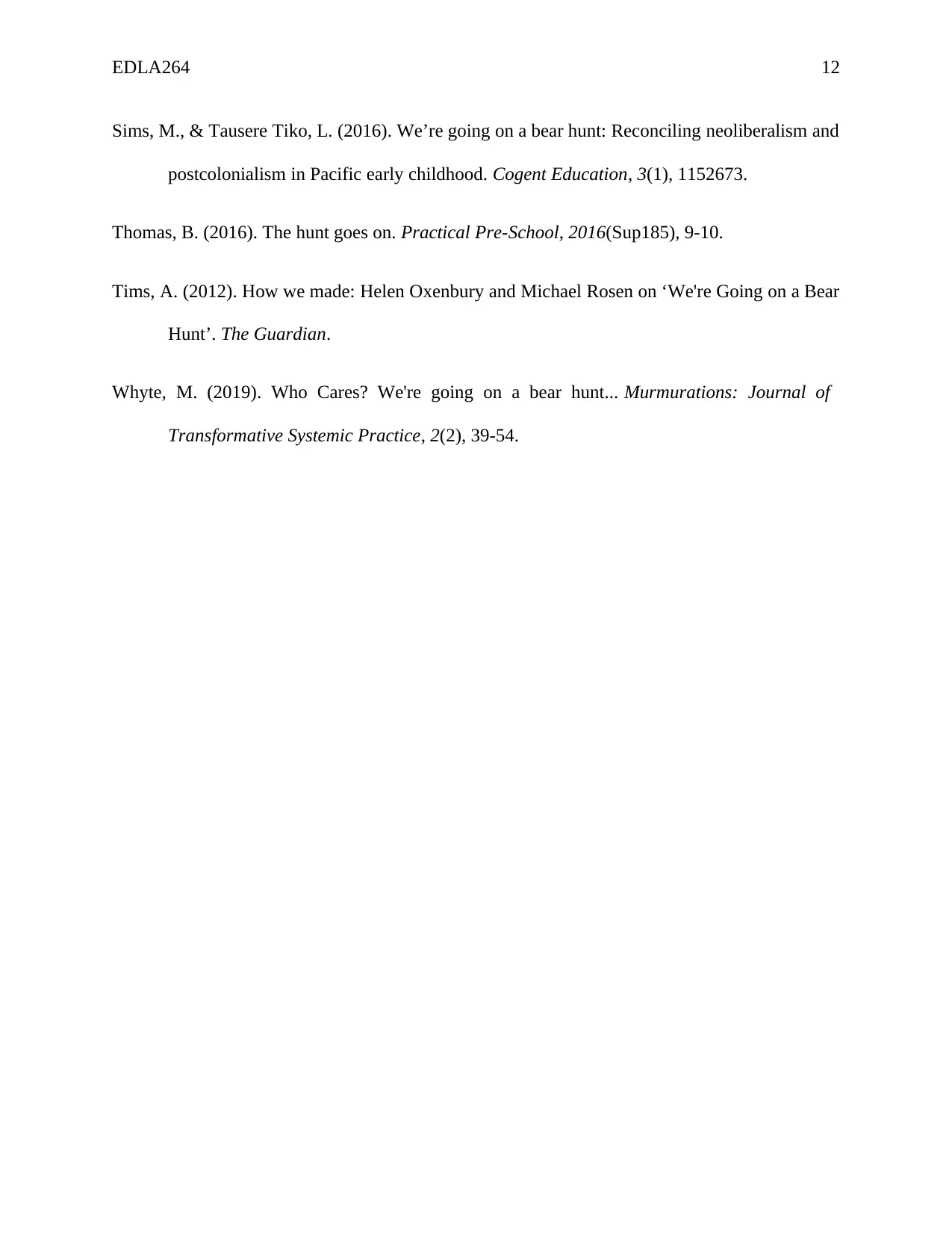
EDLA264 12
Sims, M., & Tausere Tiko, L. (2016). We’re going on a bear hunt: Reconciling neoliberalism and
postcolonialism in Pacific early childhood. Cogent Education, 3(1), 1152673.
Thomas, B. (2016). The hunt goes on. Practical Pre-School, 2016(Sup185), 9-10.
Tims, A. (2012). How we made: Helen Oxenbury and Michael Rosen on ‘We're Going on a Bear
Hunt’. The Guardian.
Whyte, M. (2019). Who Cares? We're going on a bear hunt... Murmurations: Journal of
Transformative Systemic Practice, 2(2), 39-54.
Sims, M., & Tausere Tiko, L. (2016). We’re going on a bear hunt: Reconciling neoliberalism and
postcolonialism in Pacific early childhood. Cogent Education, 3(1), 1152673.
Thomas, B. (2016). The hunt goes on. Practical Pre-School, 2016(Sup185), 9-10.
Tims, A. (2012). How we made: Helen Oxenbury and Michael Rosen on ‘We're Going on a Bear
Hunt’. The Guardian.
Whyte, M. (2019). Who Cares? We're going on a bear hunt... Murmurations: Journal of
Transformative Systemic Practice, 2(2), 39-54.
⊘ This is a preview!⊘
Do you want full access?
Subscribe today to unlock all pages.

Trusted by 1+ million students worldwide
1 out of 12
Your All-in-One AI-Powered Toolkit for Academic Success.
+13062052269
info@desklib.com
Available 24*7 on WhatsApp / Email
![[object Object]](/_next/static/media/star-bottom.7253800d.svg)
Unlock your academic potential
Copyright © 2020–2025 A2Z Services. All Rights Reserved. Developed and managed by ZUCOL.


